Safe Remote Work
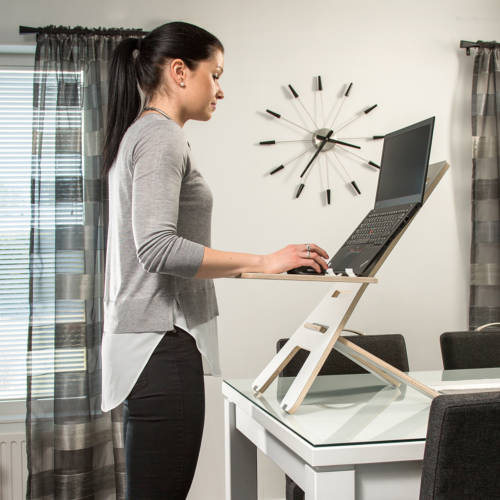
Sivun sisällysluettelo
- Background, definition and different forms of remote work
- Requirements for remote work
- Management of remote work
- Benefits and challenges of remote work
- Agreeing on remote work and good practices
- How to succeed in remote work
- Occupational health and safety management
- Accident prevention and insurance coverage
- Ergonomics
- Sources and more information
Background, definition and different forms of remote work
Remote work refers to flexible work that is based on voluntariness, agreements and rules, performed outside the employer’s premises. Remote workers may work in one or several locations, and the duration and regularity of remote work may vary greatly.
Communication technology can be used to support interaction and networking. Models of interaction and the concepts of time and place are constantly changing in the online environment. Information systems and virtual workspaces are platforms that can be used to support the work of groups and individuals.
Work can carried out in an environment where it is most effective and appropriate for the employee, the employer and the task in question. People typically do remote work from their home or holiday home, on the move, or from a remote workstation appointed by the employer.
Not all tasks are suitable for remote work, but traditional, in-office work can be flexibly combined with remote work, like working from home once a week, doing project work and completing certain work phases or administrative tasks remotely, or working while traveling.
The amount of remote work may vary from short-term to full-time and from occasional to regular, depending on the situation. The main idea is to increase flexibility on the terms of both the employer and the employee.
The EU level framework agreement on remote work and several industry-specific collective agreements discuss the terms and conditions of remote work.
Forms of remote work
Remote work may be
- irregular
- separately agreed on with the supervisor on a case-by-case basis
- carried out while on a business trip, for example
- performing a specific task
- regular
- carried out according to a pre-agreed, regular schedule
- e.g. on certain days of the week or for a certain number of days per week/month
- full-time, in which case the work is entirely or mainly remote work
- on the move, in which case the work is carried out
- at the organization’s other offices
- in cafés, airports, hotels, customer premises and various other places.
Requirements for remote work
The requirements for remote work include functional technology, proper data security and trust between the employer and the employee. The remote work environment should be healthy, safe, peaceful and suitable for the task.
Remote work management is often handled virtually, as there are less opportunities for face-to-face encounters with the supervisor. For remote managers, issues such as building and maintaining trust, creating common rules through cooperation, setting goals and monitoring their implementation are particularly emphasized. Means for monitoring the workload and work atmosphere and the readiness to respond to faults and deviations in time are also required. The risks of remote work should be included in the assessment of occupational health and safety risks, and good orientation should be provided.
Rules, good meeting practices, communal tools and their active use are needed to ensure the smooth flow of work, cooperation, communality and the development of the organization’s strategic competences. Remote workers have to be responsible, able to work independently and to draw the line between work and free time.
Requirements for remote work
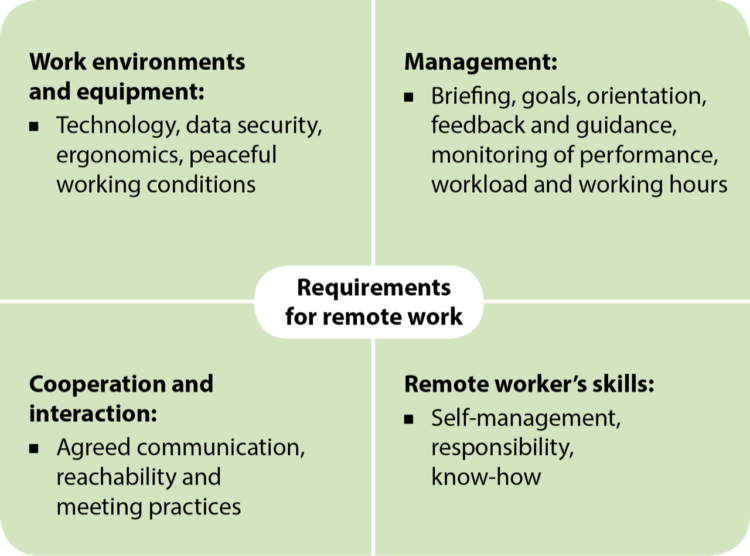
Management of remote work
Good management is essential for both remote and in-office work. Good management is about providing guidance, feedback, encouragement and support. It can also be about supervision and intervention. The aim is to achieve the desired results together. Face-to-face interaction is also needed to maintain trust in the work community, to develop skills and to achieve results.
Management needs vary from person to person. Some need more guidance and encouragement or supervision and intervention than others. Also, keep in mind that remote work is not the best solution for all tasks, situations and people. Remote work requires the ability to manage oneself. If an employee does not possess this ability, the lines between work and free time may become blurred, which may lead to health problems and problems in both private and work life. It is not sensible, however, to restrict remote work just because it is not suitable for everyone or for all situations.
It is the supervisor’s job to keep an eye on the work performance, working hours and workload of the employees, and to enable the development of the organization’s competences. The supervisor has to keep a close eye on the workload and react quickly when the need arises. A model for monitoring occupational well-being that takes the special features of remote work into account can be developed in cooperation with occupational health care and occupational safety personnel.
The employer must ensure that the working conditions are healthy and safe, regardless of the time or place of work. A good supervisor creates the conditions for productive work and keeps in touch with the employees, quickly addressing any concerns regarding the work environment, work performance, motivation or well-being at work.
Communication should be close and efficient, and keeping to the agreed attendance days at the office is important. Securing interaction and the flow of information and promoting group dynamics require both the supervisor and the employees to be active. The flow of information should be assessed regularly, particularly in situations where a lot of remote work is being done. Training in the use of communication technology must be provided, and help must be available also for remote workers when needed. The tools and software must also function properly.
Remote work should be evaluated regularly and critically. When remote work is designed and executed properly, everybody wins. If necessary, remote workers may be required to be present at the office on certain days or to keep closer contact with other members of the work community. It is a good idea to actively tell your supervisor about your accomplishments and work-related concerns.
Tips for managing remote work
- Being familiar with the content of the work tasks
- Building trust
- Interaction, sharing experiences, getting to know to your employees
- Assigning responsibility, involving people, follow-up
- Interaction
- Providing communication channels and securing the flow of information
- Arranging face-to-face meetings and reciprocity
- Creating the necessary preconditions
- Creating remote work policies and rules, adjusting processes
- Ensuring the suitability of data security, workspaces and work equipment
- Performance management
- Setting goals, creating follow-up systems, giving feedback, rewarding, coaching
- Division of tasks
- Workload monitoring and well-being support
- Strengthening the community spirit, everyday support, genuine interest, motivation, encouragement.
- Strengthening the community spirit, everyday support, genuine interest, motivation, encouragement.
Personal leadership is also required from remote workers:
- Ability to work independently
- Skills related to tasks, use of tools and time management
- Self-initiative and active contact with the supervisor, the work community and other relevant parties.
Benefits and challenges of remote work
Meaningful and productive work must be the starting point of remote work. At its best, remote work contains just the right amount of peaceful working conditions and presence in the work community. The benefits of remote work are obvious also from the point of view of transport, housing, environmental protection and regional policy.
Remote work can make life easier, but it may also cause the lines between work and free time to become blurred. This may lead to work strain and have adverse effects on the employee’s private life. Other challenges of remote work may include isolation, the development of communality and disrupting the flow of work.
- Ability to influence your own work arrangements
- Attractiveness of work, occupational well-being, productivity
- Taking the needs of your private life into account, personal freedom
- Fitting work and family life together
- Peaceful working conditions
- More efficient and rational time use (cf. commuting and traffic congestion)
- Reduced risk of commuting accidents
- Reduced risk of contracting and spreading infectious diseases
- Financial savings in facility costs
- Reduced fuel consumption and environmental damage.
- Blurring the lines between work and free time
- Disturbances in the surrounding environment
- Leadership and management: insufficient guidance, supervision, support and feedback
- Problems related to workload and time management
- Isolation, exclusion from the work community
- Compromising the development of trust, cooperation and competences
- Agreeing on schedules together, e.g. the time of compulsory meetings
- Working while sick
- Failure to identify the need for early support
- Covering up conflicts in the work community
- Failure to identify substance abuse problems, risk of the problem getting worse.
Agreeing on remote work and good practices
The employee and supervisor must agree on the remote work before starting it. The principles concerning the entire work community are agreed in cooperation. The following matters between the supervisor and the remote worker are defined in the remote work agreement: the amount of remote work, schedule, expenses, duration of the agreement, other necessary matters and practices agreed on together at the workplace. When agreeing on remote work, always remember to treat all employees equally.
The concerned parties may agree on remote work already when drawing up the employment contract, provided that the employee has originally been hired for remote work. The parties can also agree on remote work later during the employment relationship. Switching from working on the employer’s premises to remote work is voluntary for both the employer and the employee. This means that the employee does not have an unconditional right to demand access to remote work, and the employer cannot force the employee to do remote work. It is a good idea to draw up the remote work agreement in writing.
The concerned parties may agree that the remote work arrangement is valid for a fixed period; alternatively, a certain minimum period may be agreed on, after which the remote work will continue for an indefinite period, provided that both parties so wish. It may be a good idea to agree on the possibility of canceling the remote work arrangement, especially in the case of longer remote work arrangements, so that either party may terminate the arrangement with a period of notice of two months, for example. The notification to end remote work does not lead to the termination of the employment contract, only to the termination of the remote work arrangements.
Regarding work arrangements, it is necessary to agree at least on reporting arrangements, communication with the workplace and working time arrangements.
Remote work nearly always leads to costs, and the concerned parties must always agree on the compensation of these costs before switching to remote work. The employer usually acquires the equipment and tools needed for remote work and is responsible for their installation, maintenance and technical support. The employee and the employer may also agree that the employee will use their own work equipment, in which case the parties will agree on the potential compensation paid by the employer. Telecommunication costs may include a broadband subscription fee and other telephone charges.
Remote work may require more detailed discussions and agreements regarding business trips and commuting and their compensation than usual. As a general rule, the employer does not reimburse travel expenses between home and the place of work.
The employer is responsible for the occupational health and safety of the remote worker. However, certain provisions of the Occupational Safety and Health Act apply to home conditions only to a limited extent.
Before switching to remote work, attention should be paid to the specific hazards and risks of remote work and to the working conditions of the remote workplace. Mental stress factors and issues related to ergonomics are often emphasized in remote work.
Occupational accidents that occur during remote work are covered by statutory accident insurance. However, drawing the line between work and free time can sometimes be difficult, and a voluntary leisure time accident insurance (paid either by the employer or the employee) is recommended.
According to the framework agreement on remote work, the employer is responsible for data security and related costs. The employee, on their part, must follow the data security instructions given by the employer.
When agreeing on remote work, you should determine at least the following:
- remote workplaces and tasks and related limitations imposed by e.g. data security
- notification process for remote work days
- starting and ending remote work
- notification process for absence due to illness
- when remote work is not possible
- reachability
- reporting obligation
- response time to contacts
- monitoring of working hours
- work equipment, its acquisition and maintenance
- occupational health and safety issues, ergonomics
- data protection
- reimbursement of costs.
Good practices of remote work
- Equal treatment
- Orientation
- Regular in-office days and remote days
- Good meeting practices
- Regular discussions with the supervisor, also face-to-face
- Utilizing social media
- Time management and monitoring
- Systematic development of competences.
How to succeed in remote work
If your workplace does not have an existing model for remote work or you are not covered by it, follow these steps:
- Write down your key work tasks at the office.
- Which tasks do not require you to be present at the office, and which ones do?
- What problems or challenges could be associated with performing work tasks remotely?
- Find out your work organization’s responsibilities and rules related to remote work.
- Talk about working remotely with your supervisor.
- Think about where you would want to work and where you would feel inspired.
- Find out what kind of technology, software and tools you need for remote work. Also, find out where to get technical support if you need it.
Tips for remote work:
- “Time to work!” Tell people in your remote work environment, such as family members, that you need peace and quiet because you are about to start working.
- Make sure that you work ergonomically. A good working position is critical.
- Plan your work day (including breaks) in advance.
- Actively communicate with your colleagues, supervisor and partners.
- Make use of social media and other channels.
- Attend meetings and seminars, meet people also face-to-face.
- Remember to take breaks. Your body and mind need exercise!
- Switch your work environment from time to time: work in a café, in a park or at the library, for example, if your work allows it.
- Invite your colleagues to work with you!
Occupational health and safety management
The employer is responsible for the safety and health of all employees, including remote workers. The employer has limited capacity to monitor working conditions, working hours and workloads in remote environments, so good cooperation practices should be developed for occupational safety management.
You need to have the nature and specific features of remote work under control, so that you are prepared for potential risks and problems and can create safe, healthy conditions that also support remote work. The Occupational Safety and Health Act demands that the hazards and risks related to work are identified and assessed, and that preventive and corrective measures are taken. When planning an assessment, you should consider how to assess the risks and what risks are emphasized in remote work.
The Centre for Occupational Safety has produced a form to support the assessment of risks and hazards related to remote work. Employees may use the form e.g. when discussing with their supervisor. You can also make use of the expertise of the occupational health care and occupational safety personnel when needed. Based on the assessment, the concerned parties can agree on the measures needed to ensure the safety of remote work.
A work well-being diary helps employees detect the biggest shortcomings in their own work, in the work environment and in work well-being. Regular health check-ups for remote workers are useful.
Aspects of the work environment when determining the risks and hazards of work
Physical and technical
- facilities, space arrangements, decoration, furnishing and equipment solutions
- machinery, equipment, indoor climate, acoustics, lighting
Functional
- work, working positions, working motions
Psychosocial
- work management and organization
- cooperation, communication and interaction
- individual behavior in the work community
Virtual
- technological solutions, tools, various applications
- platforms and services for tasks that are executed through different interfaces.
Accident prevention and insurance coverage
Insurance coverage, as defined in the Workers’ Compensation Act, applies to all work performed in an employment relationship, including remote work. The insurance coverage for remote work done at home is limited, however, and tied to the work task. In remote work, only accidents that occur in connection with activities directly related to the employee’s agreed remote work tasks are considered occupational accidents and are thus compensated for. The activity must have a principal and essential connection to the work. Employees are compensated for accidents that have occurred outside the place of work only if the actions leading to the accident have a causal connection to the work.
Accidents during remote work that have occurred during e.g. lunch or a similar break are not covered by insurance. If the employee does e.g. household chores during work, accidents that occur during this time are not considered occupational accidents and are thus not compensated for. In these cases, the accident is not considered to be an occupational accident or an accident that has occurred under work-related circumstances.
Insurance does not cover so-called acceptable deviations during regular commute. If you e.g. fall over during a remote work day when picking up your child from day care, the accident is not covered by occupational accident insurance. A similar accident would be considered a commuting accident and would be compensated for under certain conditions if the employee had been coming home from work normally and stopped by at the day care center on their way home.
If the employer so wishes, they may strengthen the insurance coverage of their employees by taking out a voluntary insurance, such as a leisure time group insurance that complies with the Employment Accidents Insurance Act. This insurance covers staff accident risks during their free time, including remote work accident risks not covered by statutory accident insurance.
Employees can also strengthen their insurance coverage themselves by taking out a personal insurance. Every remote worker should look into their insurance coverage, but the most important thing is to always remember the principles of safety: identify the hazard – take all necessary measures that you can to eliminate the hazard or ask for help – act only when safety is secured.
Examples of non-compensable accidents during remote work:
The injured party slipped during remote work while taking a break outside, falling down and breaking their left wrist.
The injured party left their hand between the washing machine door when picking up laundry from the machine while working remotely at home.
The injured party tripped on children’s toys in the stairwell and fell down.
Examples of compensable accidents during remote work:
The injured party got up from their desk to get a letter from the printer and banged their knee on the corner of the desk.
The injured party slipped and sprained their ankle when taking work-related documents to the mail.
The injured party moved their car out of the way of a customer’s car in their own yard and slipped.
Ergonomics
Remote work is usually display terminal work. The Occupational Safety and Health Act and the Government’s decision on display terminal work contain employer obligations regarding ergonomics, which must be applied also in remote work where possible:
- Display terminal workstations must be assessed from the perspective of occupational health and fixed if necessary.
- The work environment, hardware and software must meet the minimum requirements.
- The work must not be too monotonous, or there must be sufficient breaks.
- Sufficient training and guidance must be provided.
- The employer must arrange an eyesight test for employees and provide them with special glasses for display terminal work if necessary.
Working position when sitting
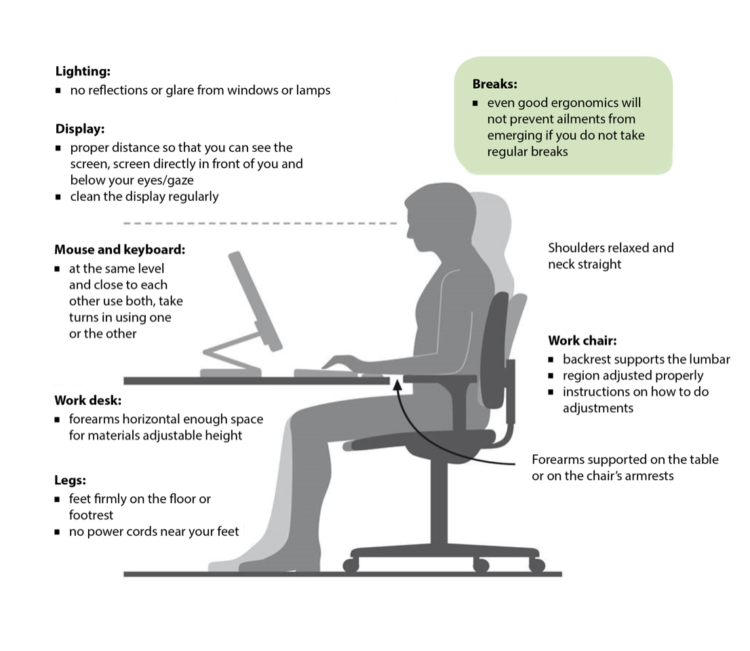
Working position when standing
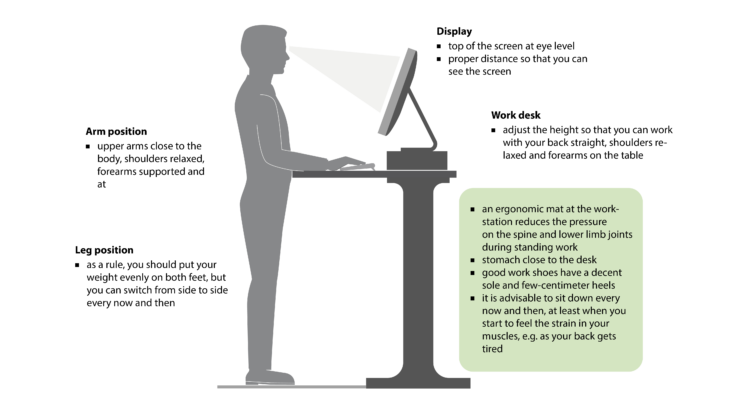
Ergonomics tips for remote work
- Try to organize your workstation at home so that there is a clear boundary between work and free time.
- For regular remote work, it is advisable to set up a permanent workstation where the work surface, display and work chair are at the right height.
- If possible, work standing up from time to time. If your work desk is not adjustable, you can get a separate platform for the desk. You can also use stacks of books to adjust your working height.
- You may need assistive equipment if you work in different locations or change your working position frequently. Some examples of such equipment include:
- additional support or cushion for the chair to support the lumbar region or neck
- stand and lap support for laptop
- detachable keyboard and mouse
- separate display
- elbow support
- ergonomic mat
- balance board
- active seat cushion
- Talk to your employer about development needs for ergonomics: could furniture or assistive equipment be borrowed?
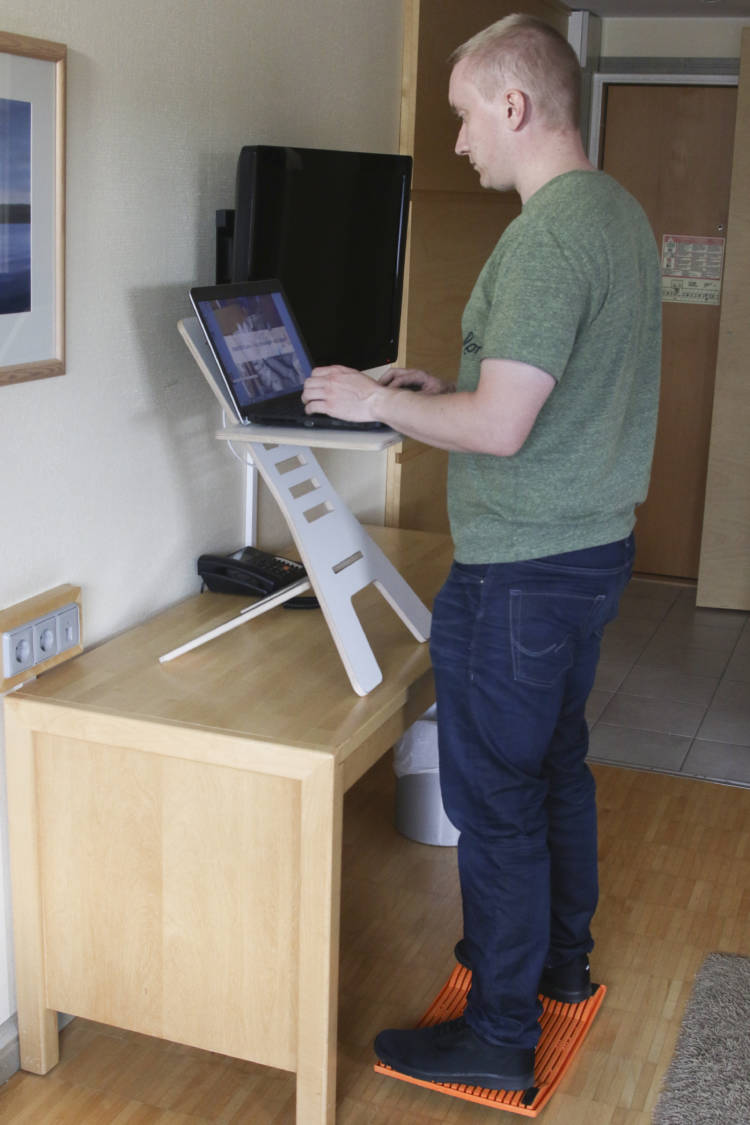
You can work while standing if you place a platform on your desk. The picture shows a platform created for this purpose that is easy to assemble and use. It can be adjusted to eight different heights. A balance board adds more movement to your work day.
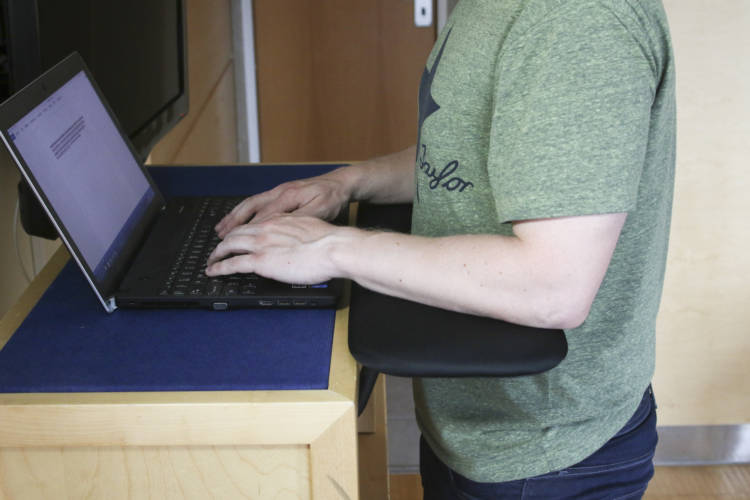
For extra arm support, install an elbow support on your desk.

A portable mat designed for standing work reduces the strain on your back and legs.

If you are reading or working on a couch, make sure that your neck stays straight. Use pillows for support.

Take breaks to do pause exercise. Push your chest forward and pull your shoulders together while rotating your thumbs out. Stay in this position for a moment. Inhale during the movement. Relax during exhalation and lower your arms to the sides. Repeat the motion a few times.

A detachable, portable backrest supports the lumbar region in sedentary work.

People who work on the train or on other vehicles should pay particular attention to their sitting position. Avoid working with your neck bent forward. A backrest or pillow may be helpful.
Sources and more information
Contact us

- Published by:
- Centre for Occupational Safety, Service Group
- Content:
- Tari Aho, Timo Höykinpuro, Erika Kähärä, Tanja Lehtoranta, Riikka Sipilä, Päivi Rauramo
- Release year:
- 2020
- Formats:
- Digital publication
- Language:
- englanti